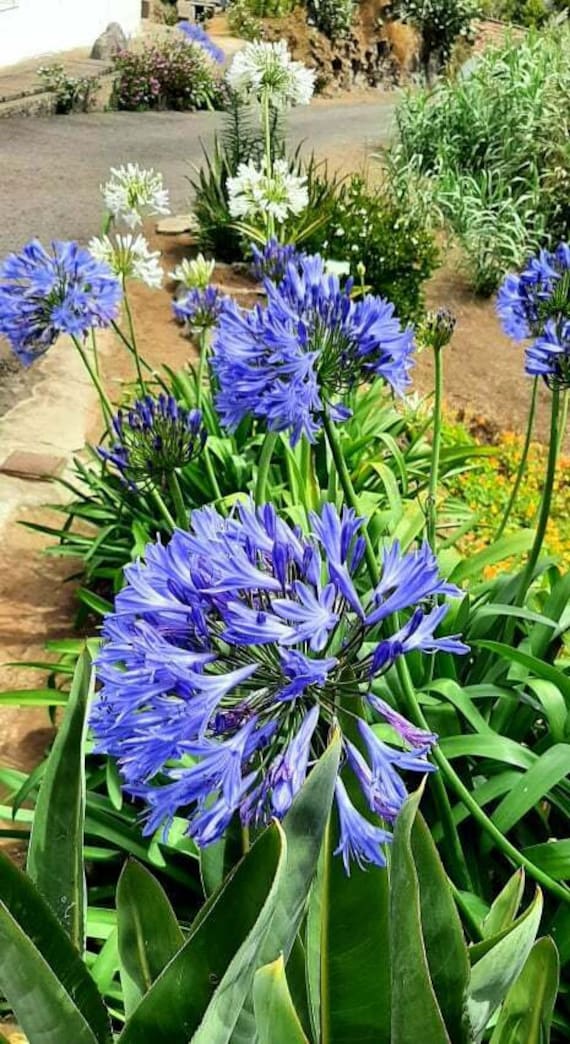Mastering the Art of Agapanthus Care: Essential Steps for Healthy Growth and Vivid Blooms
In the world of horticulture, the cultivation of agapanthus stands as a fulfilling venture for those that look for to support these elegant blooming plants. With their striking blooms and stylish vegetation, agapanthus has actually recorded the attention of gardeners worldwide. Nevertheless, achieving optimal growth and dynamic blooms requires a nuanced technique that encompasses different vital steps. From selecting the best range to mastering pruning strategies, the trip towards growing growing agapanthus plants is diverse and holds the vital to opening the complete possibility of these herb gems.

Selecting the Right Agapanthus Variety

When selecting the best Agapanthus range for your garden, think about aspects such as climate viability, blossom shade, and development routine. Agapanthus, typically referred to as Lily of the Nile or African lily, comes in a variety of colors varying from tones of purple and blue to white. Select a bloom shade that enhances your existing yard palette to develop an unified landscape. In addition, consider the climate in your region to make certain the Agapanthus variety you choose can grow in your details conditions. Some selections are a lot more forgiving of chilly temperatures, while others choose warmer climates. Comprehending the development practice of various Agapanthus varieties is crucial for correct placement within your yard. Some selections have a clumping development routine, suitable for borders or containers, while others have an even more dispersing nature, suitable for ground cover or mass plantings. By very carefully assessing these aspects, you can select the ideal Agapanthus variety to improve the elegance of your garden.
Suitable Growing Problems
Considering the optimum ecological demands is essential for successful Agapanthus cultivation. Agapanthus plants are sensitive to cold temperatures and must be protected from frost during winter months.
To make sure healthy development and lively blooms, plant Agapanthus bulbs at a depth of regarding 2-4 inches and area them 8-12 inches apart. Mulching around the base of the plants aids retain moisture and subdues weed development.
Watering and Fertilizing Tips
Maintaining proper moisture levels and offering important nutrients are crucial elements in the care program for Agapanthus plants. When it concerns watering Agapanthus, it is crucial to strike a balance. If overwatered, these plants favor constantly moist soil yet are vulnerable to root rot. Throughout the growing season, water deeply as soon as a week, making sure the soil is well-draining to avoid waterlogging. In hotter environments or throughout periods Full Report of drought, more frequent watering might be needed to keep the dirt evenly moist. However, lower watering in the winter season to avoid water logged conditions.
Feeding Agapanthus is important for promoting healthy and balanced development and prolific blooms. Use a balanced fertilizer, such as a 10-10-10 formula, in the very early springtime as brand-new growth emerges. By following these watering and feeding pointers, you can ensure your visit this site right here Agapanthus plants grow and generate vivid, lasting flowers.
Pruning Methods for Agapanthus
Trimming Agapanthus plants at the appropriate times and with appropriate strategies is critical for preserving their health and advertising optimum growth and flowering. The suitable time to prune Agapanthus is in late winter months or early springtime prior to new development arises. Begin by eliminating any yellowing or dead fallen leaves near the base of the plant. Cut them as close to the ground as feasible without harming the emerging shoots.
For flowered stems, wait up until the flowers have actually perished and afterwards trim them back to the base. This not just cleans the plant's look however likewise motivates the advancement of brand-new blossom buds. Deadheading invested blossoms can likewise redirect the plant's power right into generating even check these guys out more blossoms instead than establishing seeds. Nonetheless, if you want to accumulate seeds for breeding, leave some blossoms to mature and completely dry on the plant.
Keep in mind to use tidy, sharp tools to make accurate cuts and reduce the threat of introducing illness. Agapanthus. Regular pruning will certainly assist keep your Agapanthus looking neat and healthy while guaranteeing an abundant screen of gorgeous blooms
Taking Care Of Usual Insects and Illness
After ensuring correct pruning techniques for Agapanthus, it is necessary to deal with typical insects and conditions that can influence the health and wellness and vitality of these plants. Agapanthus plants are generally durable yet can still come down with particular issues. One common pest that affects Agapanthus is the Agapanthus gall midge. This little, orange fly lays its eggs in the foliage, resulting in distorted growth and flower buds that stop working to open up. To battle this parasite, prune and destroy any type of damaged plant parts and take into consideration using insecticidal soap.
In addition, Agapanthus plants can experience from origin rot if they are grown in inadequately draining pipes soil. By being vigilant and taking punctual activity against parasites and illness, you can help your Agapanthus plants grow and generate lively flowers. Agapanthus.

Verdict
To conclude, grasping the art of agapanthus care includes picking the ideal selection, giving suitable planting problems, correct watering and feeding, ideal trimming methods, and addressing common bugs and conditions. By adhering to these necessary steps, you can guarantee healthy development and lively blooms for your agapanthus plants. Bear in mind to on a regular basis check and preserve your plants to promote their total health and longevity.
To make sure healthy and balanced growth and vivid blossoms, plant Agapanthus light bulbs at a deepness of regarding 2-4 inches and space them 8-12 inches apart. By adhering to these watering and fertilizing pointers, you can guarantee your Agapanthus plants thrive and produce lively, lasting blooms.
One typical insect that affects Agapanthus is the Agapanthus gall midge. In addition, Agapanthus plants can suffer from origin rot if they are grown in poorly draining dirt. By following these necessary actions, you can make certain healthy and balanced development and lively blossoms for your agapanthus plants.
 Val Kilmer Then & Now!
Val Kilmer Then & Now! Destiny’s Child Then & Now!
Destiny’s Child Then & Now! Marques Houston Then & Now!
Marques Houston Then & Now! James Van Der Beek Then & Now!
James Van Der Beek Then & Now! Samantha Fox Then & Now!
Samantha Fox Then & Now!